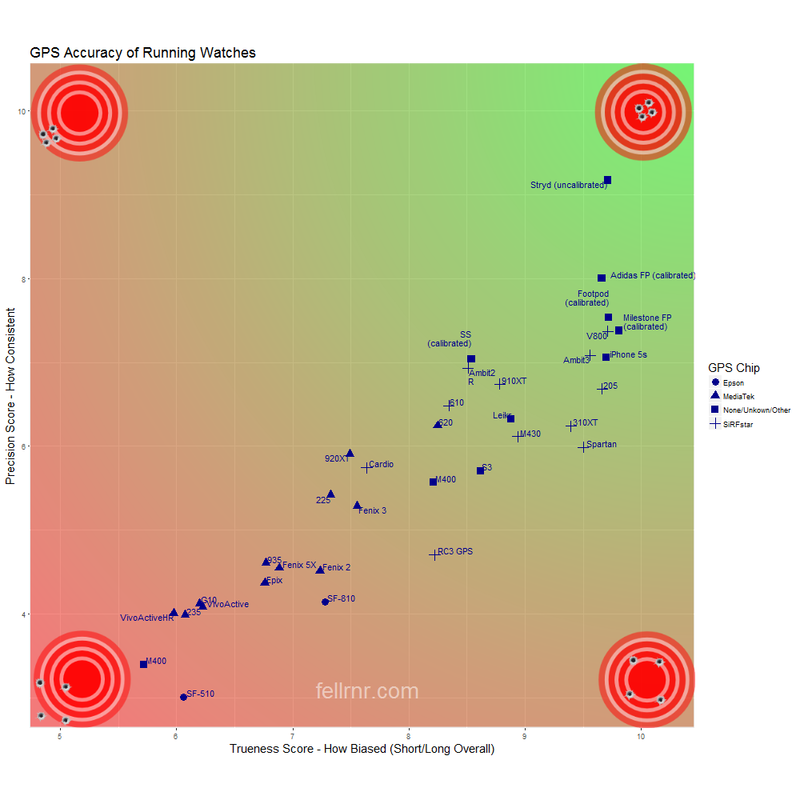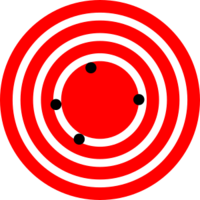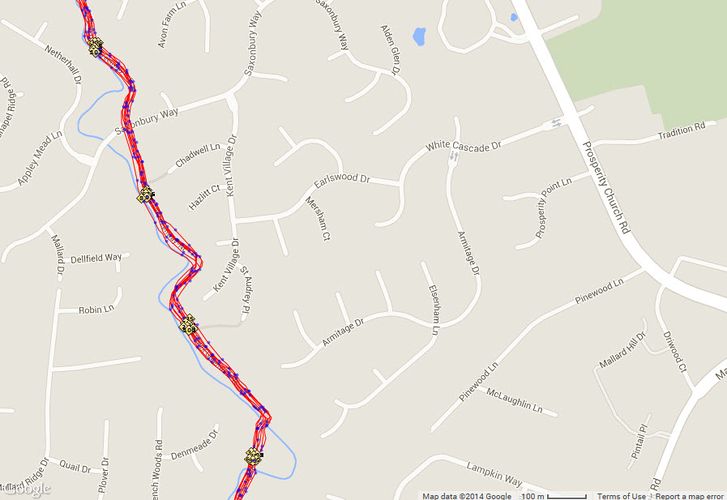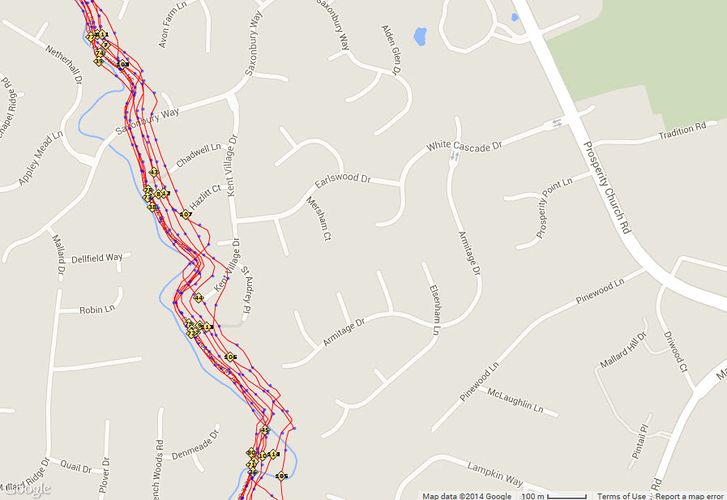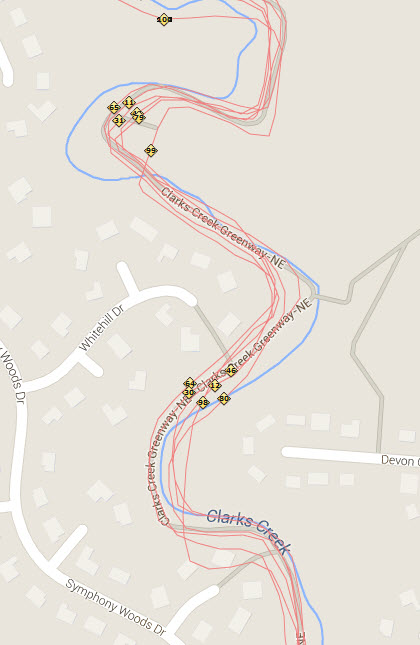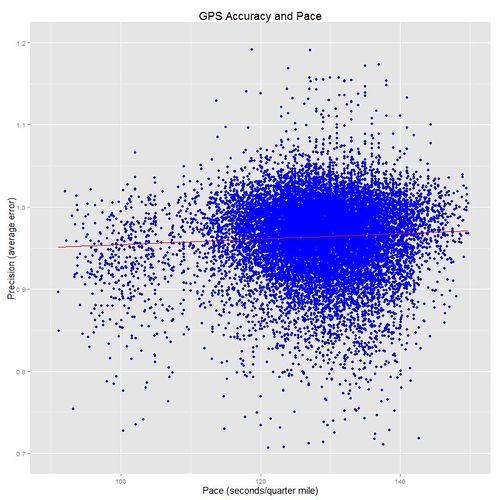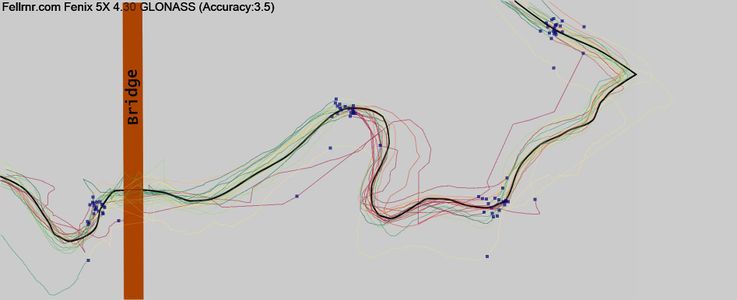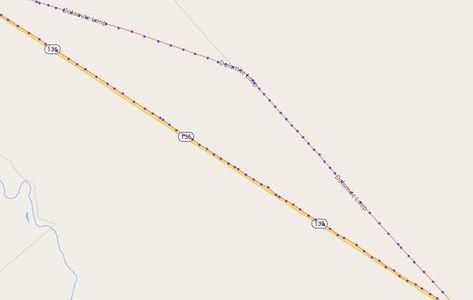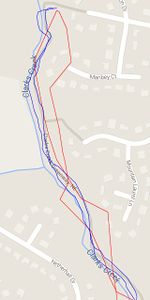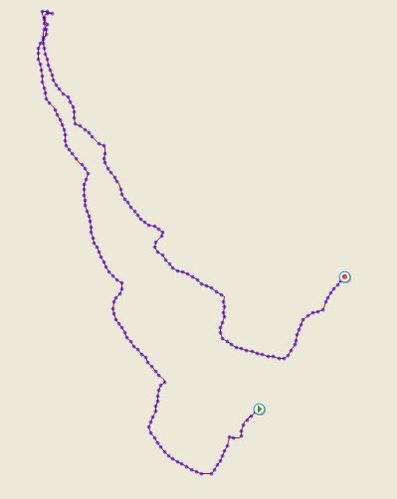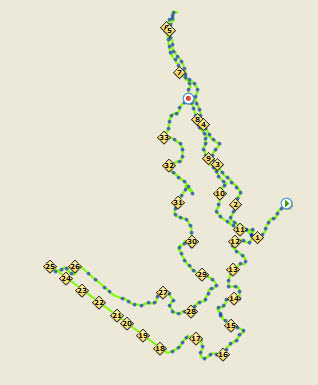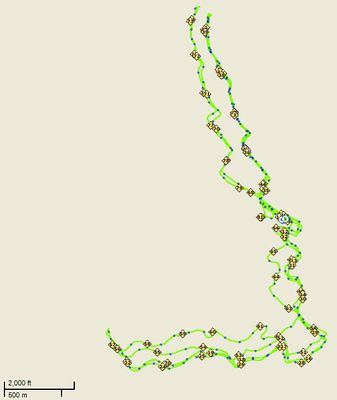GPS Accuracy of Garmin, Polar, and other Running Watches
Contents
- 1 Methodology
- 2 Accuracy, Trueness and Precision (plus Repeatability)
- 3 Accuracy
- 4 Footpod Accuracy
- 5 Trail Running and GPS
- 6 Which Chipset?
- 7 Even GPS Watches have Bad Days
- 8 Some Devices Are Better Than Others
- 9 GPS Short and long measurements
- 10 GPS Accuracy and Weather
- 11 GPS Accuracy and Seasons
- 12 GPS Accuracy and Pace
- 13 GPS and GLONASS
- 14 GPS Accuracy and Sampling Rate
- 15 GPS Accuracy and Recording Rate (Smart/1-Second)
- 16 Device Specific Notes
- 17 Garmin 620 Issues
- 18 Garmin Fenix 2 Issues
- 19 Next Steps
I evaluated the real-world accuracy of GPS watches while running over 12,000 miles/19,000Km and recording over 50,000 data points as part of my evaluation of the Best Running Watches. Under good conditions most of the watches are remarkably good, but when things get a little tough the differences become more apparent. However, none of the watches have GPS accuracy that is good enough to be used for displaying your current pace. As a result, I've added the test results for various Footpods as they can be far more accurate than GPS, but more importantly they tend to have far less moment-to-moment variation so they can give a far better display of your current pace. (Note that my accuracy tests focus on the ability to measure distance, not the moment in time position, though the two are obviously related.)
The table below is a simplified summary of the results, where a '10' would be a perfect device. (For an explanation of the ISO 5725 terms 'trueness', 'precision' and 'accuracy', see below.)
| Device | Accuracy | Trueness | Precision | Repeatability | Chipset Make | Chipset Model or Architecture | Review | Rank |
|---|---|---|---|---|---|---|---|---|
| Stryd Footpod (uncalibrated) | 9.4 | 9.7 | 9.2 | 9.3 | None | None | Stryd Review | 1 |
| Adidas Speed Cell FP (calibrated) | 8.6 | 9.7 | 8.0 | 8.2 | None | None | Footpod | 2 |
| Garmin Footpod (calibrated) | 8.2 | 9.7 | 7.5 | 7.6 | None | None | Footpod | 3 |
| MilestonePod Footpod (calibrated) | 8.1 | 9.8 | 7.4 | 7.7 | None | None | MilestonePod Review | 4 |
| Polar V800 | 8.1 | 9.7 | 7.4 | 8.1 | SiRFstar | SiRFstarIV | Polar V800 Review | 5 |
| Suunto Ambit3 Run | 7.9 | 9.6 | 7.1 | 7.8 | SiRFstar | SIRFstarV | Suunto Ambit3 Run Review | 6 |
| iPhone 5s | 7.9 | 9.7 | 7.1 | 7.6 | Qualcomm | WTR1605L | Running With A Smartphone | 7 |
| Suunto Spartan Trainer 1.10.28 | 7.8 | 8.8 | 7.2 | 8.0 | MediaTek | MT3339 | Suunto Spartan Trainer Review | 8 |
| Polar Stride Sensor Footpod (calibrated) | 7.7 | 8.5 | 7.0 | 8.0 | None | None | Footpod | 9 |
| Garmin 205 | 7.6 | 9.7 | 6.7 | 7.0 | SiRFstar | SiRFstarIII | 10 | |
| Suunto Ambit2 R | 7.6 | 8.5 | 6.9 | 7.8 | SiRFstar | SIRFstarIV | Suunto Ambit2 R Review | 11 |
| Garmin 910XT | 7.5 | 8.8 | 6.7 | 7.6 | SiRFstar | SIRFstarIV | Garmin 910XT Review | 12 |
| iPhone 4s | 7.5 | 9.0 | 6.6 | 7.2 | Broadcom | BCM4330 | Running With A Smartphone | 13 |
| Garmin 310XT | 7.3 | 9.4 | 6.2 | 6.6 | SiRFstar | SiRFstarIII | Garmin 310XT Review | 14 |
| Leikr | 7.3 | 8.9 | 6.3 | 7.2 | Unknown | Unknown | Leikr Review | 15 |
| Garmin 610 | 7.3 | 8.3 | 6.5 | 7.7 | SiRFstar | SIRFstarIV | Garmin 610 Review | 16 |
| Polar M430 1.0.28 | 7.2 | 8.9 | 6.1 | 7.2 | SiRFstar | SiRFstarIV | Polar M430 Review | 17 |
| Suunto Spartan Ultra | 7.1 | 9.5 | 6.0 | 7.4 | SiRFstar | CSRG0530 (SiRFstarV) | Suunto Spartan Ultra Review | 18 |
| Garmin 620 | 7.1 | 8.2 | 6.2 | 7.2 | MediaTek | MT3333 | Garmin 620 Review | 19 |
| Apple Watch 3 iSmoothRun | 7.0 | 8.9 | 5.9 | 7.0 | Apple | Unknown | Apple Watch 3 Review | 20 |
| Samsung Galaxy S3 | 6.8 | 8.6 | 5.7 | 7.0 | Broadcom | BCM47511 | Running With A Smartphone | 21 |
| Polar M400 v1.9.600 | 6.6 | 8.2 | 5.6 | 7.1 | U-blox | Unknown | Polar M400 Review | 22 |
| Garmin 920XT | 6.6 | 7.5 | 5.9 | 7.5 | MediaTek | MT3333 | Garmin 920XT Review | 23 |
| TomTom Cardio Runner | 6.6 | 7.6 | 5.7 | 7.5 | SiRFstar | SIRFstarV | TomTom Cardio Runner Review | 24 |
| Garmin 225 | 6.2 | 7.3 | 5.4 | 7.1 | MediaTek | MT3333 | Garmin 225 Review | 25 |
| Garmin Fenix 3 | 6.2 | 7.6 | 5.3 | 6.8 | MediaTek | MT3333 | Garmin Fenix 3 Review | 26 |
| Polar RC3 GPS | 6.1 | 8.2 | 4.7 | 5.9 | SiRFstar | SIRFstarIV | Polar RC3 Review | 27 |
| Garmin Fenix 2 | 5.7 | 7.2 | 4.5 | 7.2 | MediaTek | Unknown | Garmin Fenix 2 Review | 28 |
| Fenix 5X 4.30 | 5.6 | 6.9 | 4.5 | 6.8 | MediaTek | Unknown | Garmin Fenix 5X Review | 29 |
| Garmin 935 | 5.6 | 6.8 | 4.6 | 7.2 | MediaTek | Unknown | Garmin 935 Review | 30 |
| Epson SF-810 | 5.4 | 7.3 | 4.1 | 5.7 | Epson | Unknown | Epson SF-810 Review | 31 |
| Garmin Epix | 5.4 | 6.8 | 4.4 | 6.8 | MediaTek | MT3333 | Garmin Epix Review | 32 |
| Garmin 10 | 5.1 | 6.2 | 4.1 | 6.9 | MediaTek | Unknown | Garmin 10 Review | 33 |
| Garmin Vivoactive | 5.0 | 6.2 | 4.1 | 6.6 | MediaTek | Unknown | Garmin Vivoactive Review | 34 |
| Garmin 235 | 4.9 | 6.1 | 4.0 | 6.4 | MediaTek | MT3333 | Garmin 235 Review | 35 |
| Garmin VivoactiveHR | 4.9 | 6.0 | 4.0 | 6.9 | MediaTek | Unknown | Garmin Vivoactive HR Review | 36 |
| Garmin Vivoactive 3 | 4.5 | 5.8 | 3.4 | 6.5 | MediaTek | Unknown | Garmin Vivoactive 3 Review | 37 |
| Polar M400 v1.4 | 4.4 | 5.7 | 3.4 | 6.5 | U-blox | Unknown | Polar M400 Review | 38 |
| Epson SF-510 | 4.3 | 6.1 | 3.0 | 5.4 | Epson | Unknown | Epson SF-810 Review | 39 |
The values used are simply 10 minus the value for trueness (average) and precision (standard deviation from true). The overall is the combination of trueness and precision. Repeatability is how consistent a watch is in providing the same value for the same course segment. Important: Manufacturers do not typically release the type of GPS chipset used, so the information in this table is based the best available data, but it should be treated with caution.
1 Methodology
Main article: GPS Testing Methodology
Simply taking a GPS watch on a single run does not provide sufficient data to reasonably evaluate its accuracy. To gather the data for this test I ran the same route repeatedly, recording laps every quarter mile. The course is challenging for GPS, with lots of twists, tree cover, power lines, turn arounds and goes under a bridge. However, I believe that it's reasonably representative of real-world conditions, and probably less challenging than running in the city with skyscrapers.
2 Accuracy, Trueness and Precision (plus Repeatability)
For this evaluation I'll use the ISO 5725 definition ofAccuracy as the combination of trueness and precision.
We can look at trueness by measuring the average lap length and precision by measuring the standard deviation. I use the traditional approach to standard deviation (variation from mean) as well as a modified approach that uses variation from the true value. (It is more common in many fields to use "accuracy" to mean closeness to true value and "validity" to mean the combination of accuracy and precision. However, I feel that the meanings used by ISO 5725 are closer to the common usage. If a company sold 'accurate' 12 inch pipes and shipped half of them as 6 inches and half as 18 inches, they would meet the traditional definition of accuracy, but few people would be happy with the product. ) In addition, I calculate a value for "repeatability", which is a measure of how likely a watch is to give the same distance measurement for a specific course. I calculate the standard deviation for each segment of the course, and then take the average. A high repeatability score can mask poor accuracy and can convince users they have a good device.
3 Accuracy
The table below shows summary data for each device. The count field is how many measurements I have for that combination of condition and device, with each measurement being a quarter mile distance. I generally aim for over 1,000 data points to even out the effects of weather, satellite position and other factors. The Trueness is the absolute of the mean, though nearly all watches tend to read short. The standard deviation is provided based on the variance from the mean and the variance from the known true value. The average pace error is shown to give a sense of how much error you're likely to see in the display of current pace. This is an average error not a worst case. The data shown below is a summary the accuracy based on all the sections. If you'd like more detailed information, I've split off the Detailed Statistics for GPS Running Watches for the results under different conditions.
| Device | Count | Accuracy (Combined) |
Trueness (Average Distance Error) |
Precision (From mean) |
Precision (From true) |
Repeatability | Pace Error (95%) | Distance Error | ||
|---|---|---|---|---|---|---|---|---|---|---|
| (from 9:00 min/mile) | (from 5:30 min/Km) | (20 miles) | (30 Km) | |||||||
| Stryd Footpod (uncalibrated) | 321 | 0.62% (32.8 Ft/Mile, 6.2 m/Km) | 0.29% (15.2 Ft/Mile, 2.9 m/Km) | 0.77% (40.8 Ft/Mile, 7.7 m/Km) | 0.83% (43.8 Ft/Mile, 8.3 m/Km) | 0.73% (38.6 Ft/Mile, 7.3 m/Km) | 0:09 | 0:05 | 0.06 | 0.09 |
| Adidas Speed Cell FP (calibrated) | 361 | 1.43% (75.7 Ft/Mile, 14.3 m/Km) | 0.34% (17.9 Ft/Mile, 3.4 m/Km) | 1.97% (103.9 Ft/Mile, 19.7 m/Km) | 2.00% (105.6 Ft/Mile, 20.0 m/Km) | 1.78% (94.2 Ft/Mile, 17.8 m/Km) | 0:22 | 0:13 | 0.07 | 0.10 |
| Garmin Footpod (calibrated) | 3667 | 1.75% (92.6 Ft/Mile, 17.5 m/Km) | 0.28% (14.7 Ft/Mile, 2.8 m/Km) | 2.45% (129.3 Ft/Mile, 24.5 m/Km) | 2.47% (130.2 Ft/Mile, 24.7 m/Km) | 2.38% (125.6 Ft/Mile, 23.8 m/Km) | 0:27 | 0:16 | 0.06 | 0.08 |
| MilestonePod Footpod (calibrated) | 439 | 1.86% (98.1 Ft/Mile, 18.6 m/Km)** | 0.19% (10.1 Ft/Mile, 1.9 m/Km) | 2.61% (138.0 Ft/Mile, 26.1 m/Km) | 2.62% (138.4 Ft/Mile, 26.2 m/Km) | 2.33% (123.2 Ft/Mile, 23.3 m/Km) | 0:28 | 0:17 | 0.04 | 0.06 |
| Polar V800 | 1986 | 1.87% (98.8 Ft/Mile, 18.7 m/Km)***** | 0.29% (15.2 Ft/Mile, 2.9 m/Km) | 2.61% (138.0 Ft/Mile, 26.1 m/Km) | 2.63% (138.8 Ft/Mile, 26.3 m/Km) | 1.94% (102.4 Ft/Mile, 19.4 m/Km) | 0:28 | 0:17 | 0.06 | 0.09 |
| Suunto Ambit3 Run | 1261 | 2.08% (110.1 Ft/Mile, 20.8 m/Km)***** | 0.44% (23.2 Ft/Mile, 4.4 m/Km) | 2.88% (152.1 Ft/Mile, 28.8 m/Km) | 2.92% (153.9 Ft/Mile, 29.2 m/Km) | 2.17% (114.8 Ft/Mile, 21.7 m/Km) | 0:31 | 0:19 | 0.09 | 0.13 |
| iPhone 5s | 513 | 2.09% (110.4 Ft/Mile, 20.9 m/Km) | 0.30% (15.8 Ft/Mile, 3.0 m/Km) | 2.93% (154.5 Ft/Mile, 29.3 m/Km) | 2.94% (155.3 Ft/Mile, 29.4 m/Km) | 2.35% (124.2 Ft/Mile, 23.5 m/Km) | 0:32 | 0:19 | 0.06 | 0.09 |
| Suunto Spartan Trainer 1.10.28 | 590 | 2.17% (114.8 Ft/Mile, 21.7 m/Km)***** | 1.25% (65.8 Ft/Mile, 12.5 m/Km) | 2.50% (132.0 Ft/Mile, 25.0 m/Km) | 2.81% (148.4 Ft/Mile, 28.1 m/Km) | 1.99% (105.3 Ft/Mile, 19.9 m/Km) | 0:30 | 0:19 | 0.25 | 0.37 |
| Polar Stride Sensor Footpod (calibrated) | 309 | 2.33% (123.2 Ft/Mile, 23.3 m/Km)***** | 1.46% (77.1 Ft/Mile, 14.6 m/Km) | 2.53% (133.4 Ft/Mile, 25.3 m/Km) | 2.96% (156.2 Ft/Mile, 29.6 m/Km) | 2.05% (108.1 Ft/Mile, 20.5 m/Km) | 0:32 | 0:20 | 0.29 | 0.44 |
| Garmin 205 | 1155 | 2.36% (124.4 Ft/Mile, 23.6 m/Km)***** | 0.34% (17.7 Ft/Mile, 3.4 m/Km) | 3.30% (174.1 Ft/Mile, 33.0 m/Km) | 3.32% (175.1 Ft/Mile, 33.2 m/Km) | 2.97% (156.9 Ft/Mile, 29.7 m/Km) | 0:36 | 0:22 | 0.07 | 0.10 |
| Suunto Ambit2 R | 1025 | 2.41% (127.4 Ft/Mile, 24.1 m/Km)***** | 1.49% (78.8 Ft/Mile, 14.9 m/Km) | 2.67% (140.9 Ft/Mile, 26.7 m/Km) | 3.07% (162.0 Ft/Mile, 30.7 m/Km) | 2.22% (117.5 Ft/Mile, 22.2 m/Km) | 0:33 | 0:20 | 0.30 | 0.45 |
| Garmin 910XT | 701 | 2.46% (129.9 Ft/Mile, 24.6 m/Km)***** | 1.22% (64.3 Ft/Mile, 12.2 m/Km) | 3.01% (158.9 Ft/Mile, 30.1 m/Km) | 3.26% (172.1 Ft/Mile, 32.6 m/Km) | 2.40% (126.5 Ft/Mile, 24.0 m/Km) | 0:35 | 0:22 | 0.24 | 0.37 |
| iPhone 4s | 945 | 2.51% (132.4 Ft/Mile, 25.1 m/Km)***** | 1.01% (53.6 Ft/Mile, 10.1 m/Km) | 3.24% (171.0 Ft/Mile, 32.4 m/Km) | 3.40% (179.5 Ft/Mile, 34.0 m/Km) | 2.83% (149.2 Ft/Mile, 28.3 m/Km) | 0:37 | 0:22 | 0.20 | 0.30 |
| Garmin 310XT | 4801 | 2.69% (142.2 Ft/Mile, 26.9 m/Km)***** | 0.61% (32.0 Ft/Mile, 6.1 m/Km) | 3.71% (195.9 Ft/Mile, 37.1 m/Km) | 3.76% (198.5 Ft/Mile, 37.6 m/Km) | 3.35% (176.9 Ft/Mile, 33.5 m/Km) | 0:41 | 0:25 | 0.12 | 0.18 |
| Leikr | 650 | 2.71% (143.3 Ft/Mile, 27.1 m/Km)***** | 1.12% (59.1 Ft/Mile, 11.2 m/Km) | 3.49% (184.2 Ft/Mile, 34.9 m/Km) | 3.67% (193.9 Ft/Mile, 36.7 m/Km) | 2.84% (150.1 Ft/Mile, 28.4 m/Km) | 0:40 | 0:24 | 0.22 | 0.34 |
| Garmin 610 | 997 | 2.75% (145.1 Ft/Mile, 27.5 m/Km)***** | 1.66% (87.5 Ft/Mile, 16.6 m/Km) | 3.08% (162.8 Ft/Mile, 30.8 m/Km) | 3.51% (185.6 Ft/Mile, 35.1 m/Km) | 2.29% (121.0 Ft/Mile, 22.9 m/Km) | 0:38 | 0:23 | 0.33 | 0.50 |
| Polar M430 1.0.28 | 589 | 2.85% (150.4 Ft/Mile, 28.5 m/Km)***** | 1.06% (56.0 Ft/Mile, 10.6 m/Km) | 3.73% (196.7 Ft/Mile, 37.3 m/Km) | 3.88% (205.1 Ft/Mile, 38.8 m/Km) | 2.81% (148.4 Ft/Mile, 28.1 m/Km) | 0:42 | 0:26 | 0.21 | 0.32 |
| Suunto Spartan Ultra | 379 | 2.86% (150.9 Ft/Mile, 28.6 m/Km)** | 0.50% (26.3 Ft/Mile, 5.0 m/Km) | 3.98% (210.0 Ft/Mile, 39.8 m/Km) | 4.01% (211.8 Ft/Mile, 40.1 m/Km) | 2.63% (138.8 Ft/Mile, 26.3 m/Km) | 0:43 | 0:26 | 0.10 | 0.15 |
| Garmin 620 | 1039 | 2.93% (154.7 Ft/Mile, 29.3 m/Km)***** | 1.75% (92.5 Ft/Mile, 17.5 m/Km) | 3.30% (174.4 Ft/Mile, 33.0 m/Km) | 3.76% (198.3 Ft/Mile, 37.6 m/Km) | 2.79% (147.3 Ft/Mile, 27.9 m/Km) | 0:41 | 0:25 | 0.35 | 0.53 |
| Apple Watch 3 iSmoothRun | 308 | 2.97% (156.8 Ft/Mile, 29.7 m/Km)** | 1.09% (57.8 Ft/Mile, 10.9 m/Km) | 3.88% (205.1 Ft/Mile, 38.8 m/Km) | 4.05% (214.0 Ft/Mile, 40.5 m/Km) | 3.03% (160.0 Ft/Mile, 30.3 m/Km) | 0:44 | 0:27 | 0.22 | 0.33 |
| Samsung Galaxy S3 | 845 | 3.19% (168.4 Ft/Mile, 31.9 m/Km)***** | 1.38% (72.8 Ft/Mile, 13.8 m/Km) | 4.05% (214.0 Ft/Mile, 40.5 m/Km) | 4.29% (226.7 Ft/Mile, 42.9 m/Km) | 3.02% (159.2 Ft/Mile, 30.2 m/Km) | 0:46 | 0:28 | 0.28 | 0.41 |
| Polar M400 v1.9.600 | 384 | 3.38% (178.5 Ft/Mile, 33.8 m/Km)***** | 1.79% (94.5 Ft/Mile, 17.9 m/Km) | 4.02% (212.2 Ft/Mile, 40.2 m/Km) | 4.43% (234.0 Ft/Mile, 44.3 m/Km) | 2.91% (153.5 Ft/Mile, 29.1 m/Km) | 0:48 | 0:29 | 0.36 | 0.54 |
| Garmin 920XT | 858 | 3.39% (179.1 Ft/Mile, 33.9 m/Km)***** | 2.51% (132.4 Ft/Mile, 25.1 m/Km) | 3.19% (168.4 Ft/Mile, 31.9 m/Km) | 4.09% (216.0 Ft/Mile, 40.9 m/Km) | 2.48% (131.1 Ft/Mile, 24.8 m/Km) | 0:44 | 0:27 | 0.50 | 0.75 |
| TomTom Cardio Runner | 759 | 3.44% (181.7 Ft/Mile, 34.4 m/Km)***** | 2.36% (124.8 Ft/Mile, 23.6 m/Km) | 3.50% (185.0 Ft/Mile, 35.0 m/Km) | 4.25% (224.6 Ft/Mile, 42.5 m/Km) | 2.54% (134.0 Ft/Mile, 25.4 m/Km) | 0:46 | 0:28 | 0.47 | 0.71 |
| Garmin 225 | 855 | 3.75% (198.1 Ft/Mile, 37.5 m/Km)***** | 2.67% (141.1 Ft/Mile, 26.7 m/Km) | 3.68% (194.4 Ft/Mile, 36.8 m/Km) | 4.58% (242.0 Ft/Mile, 45.8 m/Km) | 2.87% (151.7 Ft/Mile, 28.7 m/Km) | 0:49 | 0:30 | 0.53 | 0.80 |
| Garmin Fenix 3 | 1019 | 3.75% (198.1 Ft/Mile, 37.5 m/Km)***** | 2.44% (129.1 Ft/Mile, 24.4 m/Km) | 4.00% (211.3 Ft/Mile, 40.0 m/Km) | 4.71% (248.7 Ft/Mile, 47.1 m/Km) | 3.21% (169.5 Ft/Mile, 32.1 m/Km) | 0:51 | 0:31 | 0.49 | 0.73 |
| Polar RC3 GPS | 1104 | 3.95% (208.5 Ft/Mile, 39.5 m/Km)***** | 1.78% (93.9 Ft/Mile, 17.8 m/Km) | 4.98% (262.7 Ft/Mile, 49.8 m/Km) | 5.29% (279.5 Ft/Mile, 52.9 m/Km) | 4.07% (214.8 Ft/Mile, 40.7 m/Km) | 0:57 | 0:35 | 0.36 | 0.53 |
| Garmin Fenix 2 | 1044 | 4.34% (229.3 Ft/Mile, 43.4 m/Km)***** | 2.77% (146.0 Ft/Mile, 27.7 m/Km) | 4.70% (248.3 Ft/Mile, 47.0 m/Km) | 5.48% (289.5 Ft/Mile, 54.8 m/Km) | 2.84% (150.1 Ft/Mile, 28.4 m/Km) | 0:59 | 0:36 | 0.55 | 0.83 |
| Fenix 5X 4.30 | 310 | 4.44% (234.5 Ft/Mile, 44.4 m/Km)***** | 3.12% (164.6 Ft/Mile, 31.2 m/Km) | 4.33% (228.7 Ft/Mile, 43.3 m/Km) | 5.45% (287.9 Ft/Mile, 54.5 m/Km) | 3.24% (171.1 Ft/Mile, 32.4 m/Km) | 0:59 | 0:36 | 0.62 | 0.94 |
| Garmin 935 | 345 | 4.45% (234.7 Ft/Mile, 44.5 m/Km)***** | 3.23% (170.7 Ft/Mile, 32.3 m/Km) | 4.19% (221.1 Ft/Mile, 41.9 m/Km) | 5.39% (284.7 Ft/Mile, 53.9 m/Km) | 2.84% (150.1 Ft/Mile, 28.4 m/Km) | 0:58 | 0:36 | 0.65 | 0.97 |
| Epson SF-810 | 627 | 4.57% (241.1 Ft/Mile, 45.7 m/Km)***** | 2.72% (143.7 Ft/Mile, 27.2 m/Km) | 5.14% (271.4 Ft/Mile, 51.4 m/Km) | 5.86% (309.3 Ft/Mile, 58.6 m/Km) | 4.27% (225.5 Ft/Mile, 42.7 m/Km) | 1:03 | 0:39 | 0.54 | 0.82 |
| Garmin Epix | 592 | 4.59% (242.5 Ft/Mile, 45.9 m/Km)***** | 3.24% (171.1 Ft/Mile, 32.4 m/Km) | 4.54% (239.6 Ft/Mile, 45.4 m/Km) | 5.63% (297.3 Ft/Mile, 56.3 m/Km) | 3.23% (170.3 Ft/Mile, 32.3 m/Km) | 1:01 | 0:37 | 0.65 | 0.97 |
| Garmin 10 | 1050 | 4.95% (261.2 Ft/Mile, 49.5 m/Km)***** | 3.80% (200.7 Ft/Mile, 38.0 m/Km) | 4.43% (233.8 Ft/Mile, 44.3 m/Km) | 5.87% (310.2 Ft/Mile, 58.7 m/Km) | 3.15% (166.3 Ft/Mile, 31.5 m/Km) | 1:03 | 0:39 | 0.76 | 1.14 |
| Garmin Vivoactive | 598 | 4.96% (262.1 Ft/Mile, 49.6 m/Km)***** | 3.78% (199.4 Ft/Mile, 37.8 m/Km) | 4.46% (235.2 Ft/Mile, 44.6 m/Km) | 5.92% (312.5 Ft/Mile, 59.2 m/Km) | 3.44% (181.7 Ft/Mile, 34.4 m/Km) | 1:04 | 0:39 | 0.76 | 1.13 |
| Garmin 235 | 899 | 5.08% (268.1 Ft/Mile, 50.8 m/Km)***** | 3.93% (207.3 Ft/Mile, 39.3 m/Km) | 4.49% (236.9 Ft/Mile, 44.9 m/Km) | 6.01% (317.4 Ft/Mile, 60.1 m/Km) | 3.59% (189.3 Ft/Mile, 35.9 m/Km) | 1:05 | 0:40 | 0.79 | 1.18 |
| Garmin VivoactiveHR | 929 | 5.10% (269.5 Ft/Mile, 51.0 m/Km)***** | 4.02% (212.5 Ft/Mile, 40.2 m/Km) | 4.37% (230.8 Ft/Mile, 43.7 m/Km) | 5.99% (316.3 Ft/Mile, 59.9 m/Km) | 3.05% (161.1 Ft/Mile, 30.5 m/Km) | 1:05 | 0:40 | 0.80 | 1.21 |
| Garmin Vivoactive 3 | 445 | 5.52% (291.5 Ft/Mile, 55.2 m/Km)***** | 4.25% (224.3 Ft/Mile, 42.5 m/Km) | 4.85% (256.3 Ft/Mile, 48.5 m/Km) | 6.55% (345.9 Ft/Mile, 65.5 m/Km) | 3.54% (186.9 Ft/Mile, 35.4 m/Km) | 1:11 | 0:43 | 0.85 | 1.27 |
| Polar M400 v1.4 | 1367 | 5.56% (293.7 Ft/Mile, 55.6 m/Km)***** | 4.28% (226.1 Ft/Mile, 42.8 m/Km) | 4.98% (262.8 Ft/Mile, 49.8 m/Km) | 6.60% (348.5 Ft/Mile, 66.0 m/Km) | 3.46% (182.8 Ft/Mile, 34.6 m/Km) | 1:11 | 0:44 | 0.86 | 1.28 |
| Epson SF-510 | 539 | 5.67% (299.5 Ft/Mile, 56.7 m/Km)***** | 3.94% (207.9 Ft/Mile, 39.4 m/Km) | 5.69% (300.4 Ft/Mile, 56.9 m/Km) | 6.99% (369.0 Ft/Mile, 69.9 m/Km) | 4.60% (243.0 Ft/Mile, 46.0 m/Km) | 1:15 | 0:46 | 0.79 | 1.18 |
The "Accuracy (Combined)" column has an indication of statistical significance compared with the most accurate entry. The key to this indication is: † p<0.05, * p< 0.01, ** p< 0.001, *** p< 0.0001, **** p< 0.00001, ***** p< 0.000001
3.1 Progress of newer watches
I expected GPS watches to improve with time, but the opposite appears to be happening. With the Garmin devices especially, you can see that the older watches generally do far better than the newer ones. I suspect this is due to compromises to get better battery life and smaller packaging and the cost of GPS accuracy.
3.2 Smartphone Accuracy
There are various things you will need to do in order to get the level of accuracy I found with Smartphones. See Optimizing Smartphone GPS Accuracy for details.
3.3 Interpretation and Conclusions
What do these statistics mean? This is my interpretation:
- Under normal conditions the GPS accuracy is quite good for most devices.
- The accuracy of a calibrated Footpod is far better than any GPS device. Without calibration the Footpod is more accurate than any watch currently on the market with the exception of the 310XT/910XT with a Footpod backing up the GPS.
- The Polar M400, Garmin Fenix 2, and Garmin 10 are noticeably poorer than the other devices. I found the accuracy of the M400/Fenix2/10 in general usage to be rather grim, and I did some testing pairing them up with the 610 or the 310XT. In all cases the Fenix2/10 would have poor accuracy compared with the 610 or 310XT on the same run.
- The Fenix2 would repeated loose satellite reception, something I've not seen (the M400 has done this once). The statistics do not reflect just how bad the Fenix2 is, as some of the data is too bad to analyze.
- The results of the Garmin 610 & 620 indicate the problems with the 10 are not inherent in a smaller device.
- The improvement in GPS accuracy of the 620 with updated firmware shows just how important the software can be. With the earlier firmware the 620 lost over a mile over a 20 mile run!
- The accuracy of all devices is better in a straight line than on curves or twisty routes. My course is a tough test for GPS devices with many curves and only a few relatively straight sections.
- Not surprisingly, for many devices accuracy drops going under the bridge. However, some devices do great in this section, probably because it's fairly straight.
- More interestingly the trueness just after the bridge is even lower, suggesting that the GPS watches are struggling to reacquire the satellites.
- The turnarounds are even less accurate than going under a bridge, but Power Lines do not seem to impact accuracy noticeably.
- The Footpod improves the accuracy of the 310XT.
- Note that I'm intentionally using an uncalibrated Footpod (factor = 1.000) to gather data for a comparison of Foodpod and GPS.
- The older Garmin 205 does remarkably well.
4 Footpod Accuracy
The accuracy of a Footpod is far higher than GPS, as well as more consistent and quicker to react to changes in pace. For any given run, the average pace error from the Footpod is only 7 seconds/mile (at a 9:00 min/mile pace) or 5 seconds/Km (at a 5:30 min/Km pace). In practical terms, I've found that I always have to use a Footpod to pace a marathon or for critical speedwork. For details of how the Footpod calibration was done, see GPS Testing Methodology.
5 Trail Running and GPS
Trail running tends to be rather harder for a watch to measure accurately. There are far more twists and turns, and for a Footpod your footsteps tend to be uneven. I realized how bad the problem was when running some mountain bike trails and my GPS watch said I'd only been traveling at walking pace. This prompted me to survey and evaluate the accuracy of various devices on these mountain bike trails. The table below is preliminary data, but you'll notice how the results are dramatically worse than my usual GPS testing. The Polar V800, which does really well on my greenway tests has serious problems on trails, though it's still one of the better watches I've tested so far. The Suunto Spartan Trainer shows its strength more clearly on the mountain bike trails, coming in far ahead of other GPS watches. The Stryd footpod is vastly more accurate than GPS, and unlike GPS it could be calibrated to improve its accuracy even further.
| Device | Accuracy | Trueness | Precision |
|---|---|---|---|
| Stryd 1.1.7 Footpod | 2.04% | 2.72% | 0.93% |
| Suunto Ambit 3 | 4.42% | 5.22% | 3.44% |
| Suunto Spartan Trainer | 5.28% | 4.85% | 5.67% |
| Polar V800 | 9.01% | 11.71% | 5.04% |
| Apple Watch iSmoothRun | 9.42% | 11.92% | 5.95% |
| Suunto Spartan Ultra | 13.01% | 17.17% | 6.61% |
| Polar M430 | 13.33% | 17.87% | 5.99% |
| Garmin Fenix 3 | 15.11% | 20.36% | 6.51% |
6 Which Chipset?
While the specific chipset used in a GPS watch will impact its accuracy, there are many other factors that come into play. The physical packaging of the chipset, the antenna used, the particular features that are implemented, and the software that interprets the raw data will influence the overall accuracy. It's important to note that the SiRF chipsets such as "SIRFstarIV" are not a single chipset, but rather an overall architecture with several specific chipsets bearing the same name.
7 Even GPS Watches have Bad Days
While it's tempting to take the various GPS watches on a single run and simply compare the totals, this is a flawed approach. Evaluating the devices GPS accuracy on the basis of a single sample does not tell you much. It's a bit like evaluating an athlete's ability on the basis of one event; everyone has good days and bad days, and that applies to GPS watches as well. To illustrate this, the images below are from two runs, recorded on 9/20 and 9/22. In each run I recorded data on both the 310 and 910 watches, hitting the lap button on both at as close to the same time as is humanly possible. On 9/20 the 910XT was far more accurate than the 310XT, but on 9/22 the situation is reversed. If you were to have evaluated the two watches on the basis of a single run, you would conclude that one is much better than the other. But which device would win would depend on the particular day. This is why I've accumulated a lot of data to do a statistical analysis to work out which is really better.
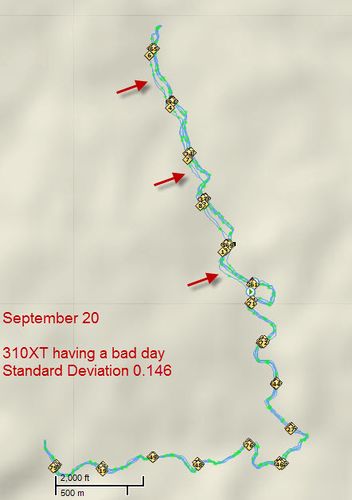 The Garmin 310XT having a bad day. You can see on the upper half of the course where it got a little confused and off track. |
 The Garmin 910XT on the same run having no problems, and only the standard, expected level of inaccuracy. |
 Two days later and it's the turn of the Garmin 310XT to have a good day. |
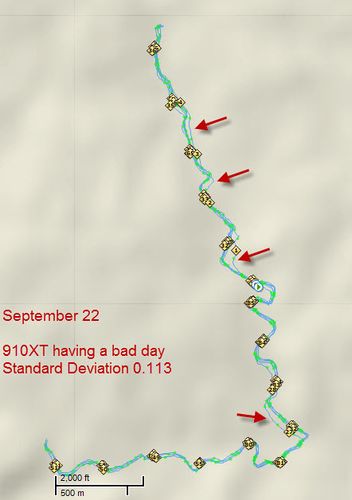 Again, this track is recorded on the same run as the image to the left. The Garmin 910XT gets a little confused at the start, and then again around lap 27. |
8 Some Devices Are Better Than Others
Below is a section of two runs showing the same section of the course, both taken at the same time, one from the Garmin 310XT and the other from the Garmin 620 with the early firmware. (With the later firmware the tracks from the 620 look like the 310XT.)
9 GPS Short and long measurements
As you can see from the images below, the GPS track tends to take shortcuts around bends, reducing the length of the measured track. This cutting of the corners indicates the devices are doing some post-hoc smoothing to try to overcome the GPS errors. The more smoothing they do, the better the accuracy is likely to be in a straight line and the worse it is around corners or twisty courses. In my discussions with engineers working on GPS systems, this type of smoothing is often performed with aKalman filter. (When I tested using software without smoothing I found the measurements were long on my course rather than short, which is almost always the case.)
Often GPS measurements of races, especially marathons record a longer distance than the race. This is partly because the USATF technique for measuring the distance takes a path that is no more than 12 inches away from the tangent (corner), and few runners are able to run that close. In a large marathon you can be forced to take a line that is a long way from the tangent. The other factor is that on a straight line, the GPS error tends to give a slightly longer measurement.
10 GPS Accuracy and Weather
GPS Accuracy is slightly better with clear skies than with cloud cover. The difference between completely clear and fully overcast is generally less than 0.1% and my testing includes a similar mix of cloud cover for each watch, so I ignore this difference. However, rain can degrade accuracy by 0.3-3.1%, with the better watches being impacted the least. Because it does not rain that frequently where I test, this has created some potential bias in my testing so I now ignore measurements taken during the rain. This has only made a slight difference to the results, but it ensures consistence.
11 GPS Accuracy and Seasons
I run in a wooded area with mostly deciduous trees, so the foliage varies by season. This foliage can have a noticeable impact on GPS accuracy, with better accuracy during the bare winter months than the rest of the year. This difference is mostly 0.1-1.5%, but in some cases can be as large as 2.5%. Because of this, my testing now ignores data from the winter months when the trees are bare. The short winter here in the south of the US means that the impact on the overall results are small, but like the weather impacts noted above, this does ensure greater consistency.
12 GPS Accuracy and Pace
There have been reports of GPS accuracy changing with pace, but as you can see from the graph above, my testing does not show this.
13 GPS and GLONASS
I have found that GPS plus GLONASS produces less accuracy than GPS alone, something that is a little counterintuitive. I have no definitive explanation for this, and I do have a working hypothesis. My thought is that enabling both GPS and GLONASS will increase the number of satellites above the horizon, and a modern chipset can have over 50 channels. This means the chipset will have access to far more satellites with both systems enabled. However, I don't believe that the chipset will use all the available satellites when calculating its position. In an urban, or wooded environment, the satellites nearest the horizon will have the weakest signal, and the satellites closest to directly overhead will have the strongest signal. If the chipset were to use only the strongest 5-6 signals, then it's likely to choose the satellites that are closest to being directly overhead. That means the satellites chosen are relatively close together, which is a poor geometry that reduces accuracy. (In GPS terms this is called Dilution of Precision, or DoP.) I've talked to a GPS specialist who tells me that they have seen this in GPS systems they've tested (though not necessarily consumer grade systems.) What this means in the real world is that if you're in an environment with a partial view of the sky due to tree cover for low buildings then GPS on its own is likely to provide better accuracy. If you're in an environment with a clear view of the sky from horizon to horizon, then it's less clear to me which system is likely to provide better accuracy, and I've not tested this in practice. Given that the theoretical accuracy of GLONASS is not quite as good as GPS I'm not sure that enabling both systems will improve matters. It's possible that GLONASS will do relatively better at extreme polar latitudes due to its different orbital patterns.
13.1 Garmin 920XT and GLONASS
The Garmin 920XT is significantly worse with GLONASS enabled.
| Device | Accuracy | Trueness | Precision | Repeatability |
|---|---|---|---|---|
| Garmin 920XT | 6.6 | 7.5 | 5.9 | 7.5 |
| Garmin 920XT (GLONASS) | 5.5 | 6.6 | 4.6 | 7.2 |
13.2 Suunto Spartan Ultra and GLONASS
The Suunto Spartan Ultra seems to do particularly poorly with GLONASS enabled.
| Device | Accuracy | Trueness | Precision | Repeatability |
|---|---|---|---|---|
| Suunto Spartan Ultra 1.6.14 | 7.1 | 9.5 | 6.0 | 7.4 |
| Suunto Spartan Ultra 1.6.14.GLONASS | 4.9 | 7.5 | 3.3 | 5.0 |
13.3 Garmin Epix and GLONASS
The Garmin Epix has slightly better accuracy with WAAS than without it, and GLONASS didn't degrade the accuracy the way it does with other devices. My belief is that enabling WAAS effectively disables GLONASS, as WAAS is GPS specific (and only available in North America.) There is EGNOS Ground Segment is the equivalent of WAAS for GLONASS/GPS/Galileo in Europe.
| Device | Accuracy | Trueness | Precision | Repeatability |
|---|---|---|---|---|
| Garmin Epix with GLONASS+WAAS | 6.2 | 7.4 | 5.3 | 7.4 |
| Garmin Epix with WAAS | 6.2 | 7.7 | 5.1 | 6.7 |
| Garmin Epix | 5.4 | 6.8 | 4.4 | 6.8 |
13.4 Garmin Fenix 5X and GLONASS
Continuing the theme of poor accuracy with GLONASS enabled, the Garmin Fenix 5X demonstrates even worse performance than its peers. The values shown below are rather dramatically worse with GLONASS enabled than without. My anecdotal observation is that sometimes the Fenix 5X does a little worse with GLONASS than normal, possibly in line with other Garmin devices, and sometimes it seems to just get lost and produce dramatically worse results.
| Device | Accuracy | Trueness | Precision | Repeatability |
|---|---|---|---|---|
| Fenix 5X 4.30 | 5.6 | 6.9 | 4.5 | 6.8 |
| Fenix 5X 4.30 GLONASS | 3.5 | 6.2 | 1.6 | 3.5 |
Below you can see a visual representation of the problems. Many of the tracks are a little worse than normal, but you generally follow the path. A small subset of the tracks are dramatically worse, either showing and offset from the actual path, or sometimes it looks like the sampling frequency has dropped, suggesting that the watch is only periodically able to get a location fix. This latter phenomenon is rather surprising to me and goes against my hypothesis of why GLONASS has worse accuracy. I would expect there would be more satellites available with GLONASS enabled, which would result in the watch selecting the subset with the strongest signal that are more likely to have a narrow angle of separation, which would result in increased Dilution of the Precision. These tracks suggest that the Fenix 5X is unable to get any location fix for brief periods.
14 GPS Accuracy and Sampling Rate
GPS watches default to recording a sample frequently enough that accuracy is not compromised. However, several devices offer the option of recording less frequently to improve battery life at the cost of accuracy. These devices actually turn off the GPS receiver, turning it on periodically for just long enough to get a fix. The images below are from the 2014 Badwater 135 using the Suunto Ambit2 R with recording set to one minute intervals. As you can see, accuracy suffers on curves, but is fine on the straights. For a course like Badwater, the one minute recording interval was fine as the course has few turns.
15 GPS Accuracy and Recording Rate (Smart/1-Second)
While the GPS sampling rate mentioned above has a huge impact on GPS accuracy, the same isn't true for recording rate. These two ideas seem to get confused. GPS sampling rate allows a watch to turn off the GPS receiver for short periods to conserve battery life while sacrificing GPS accuracy. Some Garmin watches can be configured to either record every second, or only record when something happens, such a change in heart rate or change in direction, something they call "smart recording." With a smart recording in normal GPS mode, the GPS system is continually active, so there's no loss in accuracy. To verify this, I tested the Garmin Fenix 5X in both the smart recording mode I normally use, and one second recording mode for comparison. As you can see, the two modes are virtually identical, and the differences are most likely due to chance (p=0.72).
| Device | Accuracy | Trueness | Precision | Repeatability |
|---|---|---|---|---|
| Fenix 5X 4.30 Smart Recording | 5.6 | 6.9 | 4.5 | 6.8 |
| Fenix 5X 4.30 One Second Recording | 5.3 | 7.1 | 4.0 | 6.6 |
16 Device Specific Notes
For those interested in some of the details of how devices are configured for testing, here are some additional notes.
- Garmin devices are set to 'smart recording'. I did try an informal test with the 620 using 1-second recording, but it appeared to make no difference.
- For details of the calibration of the Footpod see GPS Testing Methodology.
- The Fenix 2 was tested with and without WAAS support activated; WAAS helped slightly.
- The Garmin 920XT was tested with Watch Firmware 2.50, GPS Firmware 2.70 using smart recording.
17 Garmin 620 Issues
The Garmin 620 had some notorious problems with its GPS accuracy. The table below shows the changes with various firmware versions, culminating in the GPS-3.30 firmware that resolved the issues. I've including some testing I did without EPO data (NoEPO row below) and with a Footpod (+FP row below).
| Device | Count | Accuracy (Combined) |
Trueness (Average Distance Error) |
Standard Deviation (From mean) |
Standard Deviation (From true) |
Pace Error (95%) | Distance Error | ||
|---|---|---|---|---|---|---|---|---|---|
| Garmin 620 (original v2.80) | 412 | 3.24% (171.0 Ft/Mile, 32.4 m/Km) | 1.95% (103.0 Ft/Mile, 19.5 m/Km) | 3.65% (192.9 Ft/Mile, 36.5 m/Km) | 4.14% (218.7 Ft/Mile, 41.4 m/Km) | 0:45 | 0:27 | 0.39 | 0.59 |
| Garmin 620 (replacement v2.90) | 395 | 6.65% (351.1 Ft/Mile, 66.5 m/Km) | 5.13% (270.8 Ft/Mile, 51.3 m/Km) | 5.98% (315.7 Ft/Mile, 59.8 m/Km) | 7.88% (416.2 Ft/Mile, 78.8 m/Km) | 1:25 | 0:52 | 1.03 | 1.54 |
| Garmin 620 (replacement v3.00) | 322 | 6.24% (329.3 Ft/Mile, 62.4 m/Km) | 4.62% (243.7 Ft/Mile, 46.2 m/Km) | 5.92% (312.8 Ft/Mile, 59.2 m/Km) | 7.51% (396.8 Ft/Mile, 75.1 m/Km) | 1:21 | 0:50 | 0.92 | 1.38 |
| Garmin 620 (replacement v3.00, NoEPO) | 307 | 4.06% (214.5 Ft/Mile, 40.6 m/Km) | 2.48% (131.2 Ft/Mile, 24.8 m/Km) | 4.54% (239.8 Ft/Mile, 45.4 m/Km) | 5.18% (273.5 Ft/Mile, 51.8 m/Km) | 0:56 | 0:34 | 0.50 | 0.75 |
| Garmin 620 (replacement v3.00, +FP) | 546 | 5.04% (265.9 Ft/Mile, 50.4 m/Km) | 2.67% (140.8 Ft/Mile, 26.7 m/Km) | 6.04% (319.0 Ft/Mile, 60.4 m/Km) | 6.60% (348.7 Ft/Mile, 66.0 m/Km) | 1:11 | 0:44 | 0.53 | 0.80 |
| Garmin 620 (replacement v3.00, GPS 3.30) | 1039 | 2.75% (145.2 Ft/Mile, 27.5 m/Km) | 1.58% (83.3 Ft/Mile, 15.8 m/Km) | 3.18% (168.1 Ft/Mile, 31.8 m/Km) | 3.55% (187.7 Ft/Mile, 35.5 m/Km) | 0:38 | 0:23 | 0.32 | 0.47 |
18 Garmin Fenix 2 Issues
Like the Garmin 620, I've had similar GPS accuracy issues with the Fenix 2. In fact, the Fenix 2 is the only device I've ever had that has given the "lost satellite reception" message on my usual running route. Because of these issues Garmin replaced my Fenix 2 under warranty, and below are the results for the original and new watches. The replacement watch also gave "lost satellite reception" repeatedly and the error values for the Fenix 2 do not reflect these problems as the data from those runs was useless for analysis. I suspect there are three (possibly related) problems with the Fenix 2:
- The MediaTek GPS chipset is not as accurate as the SiRF chipset. The best results from the Fenix 2 are generally mediocre.
- The Fenix 2 records the right shape track, but offset by some distance. This does not look like a typical accuracy problem that would manifest itself randomly.
- Occasionally the Fenix 2 will report "lost satellite reception", and I have several instances of this where the date and time were wrong after reception was lost. If a GPS device has the wrong time, then it will expect the satellites to be in different positions and will be unable to acquire a position fix. I have four instances where the workout file was stored with a date in April 2019, indicating that was the date when I terminated the workout and attempted to reacquire satellite lock. In one case I noticed the date and time was set incorrectly on the watch display after the satellite lost message. There are also reports from various users about lost satellite reception and the 2019 date. This problem might also explain the offset track above, but only if the clock was out by a very small amount.
| Device | Count | Accuracy (Combined) |
Trueness (Average Distance Error) |
Standard Deviation (From mean) |
Standard Deviation (From true) |
Pace Error (95%) | Distance Error | ||
|---|---|---|---|---|---|---|---|---|---|
| Garmin Fenix 2 original 2.50 | 1396 | 4.50% (237.6 Ft/Mile, 45.0 m/Km) | 1.59% (84.1 Ft/Mile, 15.9 m/Km) | 5.95% (314.3 Ft/Mile, 59.5 m/Km) | 6.16% (325.3 Ft/Mile, 61.6 m/Km) | 1:07 | 0:41 | 0.32 | 0.48 |
| Garmin Fenix 2 replacement 3.10 | 400 | 4.91% (259.4 Ft/Mile, 49.1 m/Km) | 3.17% (167.3 Ft/Mile, 31.7 m/Km) | 5.31% (280.2 Ft/Mile, 53.1 m/Km) | 6.18% (326.5 Ft/Mile, 61.8 m/Km) | 1:07 | 0:41 | 0.63 | 0.95 |
| Garmin Fenix 2 replacement 3.20 | 570 | 5.06% (267.3 Ft/Mile, 50.6 m/Km) | 3.19% (168.3 Ft/Mile, 31.9 m/Km) | 5.56% (293.6 Ft/Mile, 55.6 m/Km) | 6.41% (338.5 Ft/Mile, 64.1 m/Km) | 1:09 | 0:42 | 0.64 | 0.96 |
| Garmin Fenix 2 replacement 3.20 (No WAAS) | 866 | 5.50% (290.6 Ft/Mile, 55.0 m/Km) | 3.10% (163.5 Ft/Mile, 31.0 m/Km) | 6.44% (339.8 Ft/Mile, 64.4 m/Km) | 7.14% (377.1 Ft/Mile, 71.4 m/Km) | 1:17 | 0:47 | 0.62 | 0.93 |
| Garmin Fenix 2 replacement 3.70 (+FP) | 720 | 5.91% (312.2 Ft/Mile, 59.1 m/Km) | 3.49% (184.1 Ft/Mile, 34.9 m/Km) | 6.75% (356.5 Ft/Mile, 67.5 m/Km) | 7.60% (401.2 Ft/Mile, 76.0 m/Km) | 1:22 | 0:50 | 0.70 | 1.05 |
| Garmin Fenix 2 replacement (Hotstart) | 213 | 4.47% (236.1 Ft/Mile, 44.7 m/Km) | 2.61% (137.7 Ft/Mile, 26.1 m/Km) | 5.13% (271.1 Ft/Mile, 51.3 m/Km) | 5.76% (304.2 Ft/Mile, 57.6 m/Km) | 1:02 | 0:38 | 0.52 | 0.78 |
| Garmin Fenix 2 replacement 4.00, GPS 3.30 | 1044 | 4.09% (215.8 Ft/Mile, 40.9 m/Km) | 2.59% (136.6 Ft/Mile, 25.9 m/Km) | 4.47% (236.3 Ft/Mile, 44.7 m/Km) | 5.17% (273.0 Ft/Mile, 51.7 m/Km) | 0:56 | 0:34 | 0.52 | 0.78 |
19 Next Steps
This is an initial analysis of the data I have, and there are a number of further evaluations to do.
- Check how GPS accuracy changes over the course of a run, as I've seen a distinct tendency for the watches to say they are good to go when they don't really have an optimal lock on the satellites. I wait for 5+ minutes between the watches saying they have sufficient satellites locked in, so this should not be a problem with the data shown here, but I could do some tests where I turn on the watch from a cold state, then start running as soon as they claim they have a lock.
- Look at how accurate the GPS watches are for measuring elevation, and compare with barometric data.
- Write up general GPS accuracy.
